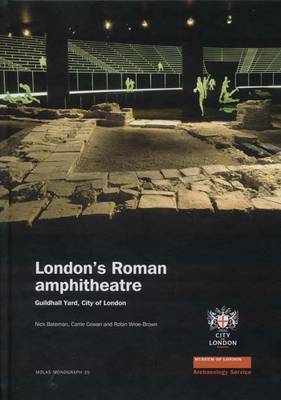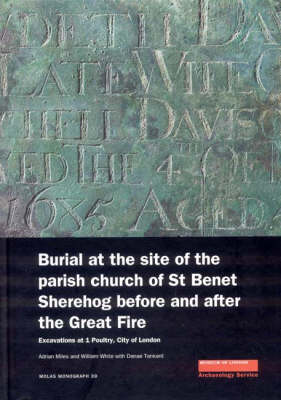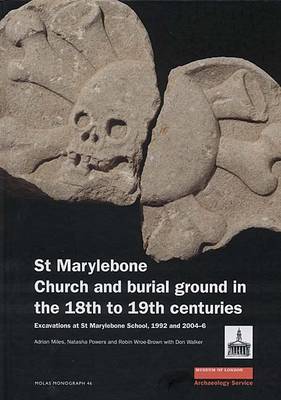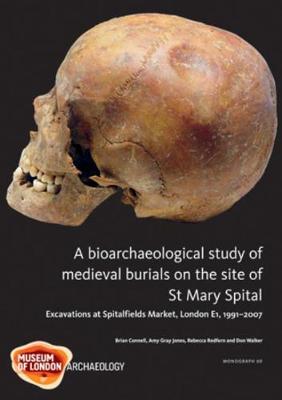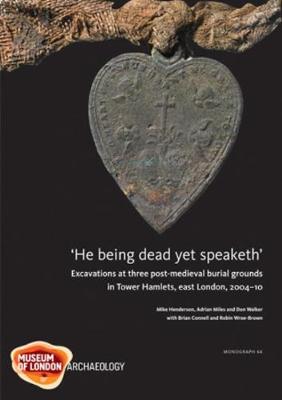MOLAS MONOGRAPH
6 primary works
Book 3
The Cross Bones Burial Ground, Redcross Way, Southwark, London
by Megan Brickley, Adrian Miles, and Hilary Stainer
Published 1 June 2012
The 19th-century parish of St Saviour's, Southwark, teemed with people - the poor and destitute living in overcrowded houses with bad hygiene, drainage and waste disposal, and an inadequate and polluted water supply. This report combines archaeological, biological and documentary evidence, using this sample of 148 burials from the...Read more
The 19th-century parish of St Saviour's, Southwark, teemed with people - the poor and destitute living in overcrowded houses with bad hygiene, drainage and waste disposal, and an inadequate and polluted water supply. This report combines archaeological, biological and documentary evidence, using this sample of 148 burials from the mid-a9th century - many of whom died young - to provide a window on a population struggling with harsh living conditions, who were poorly nourished and prone to infectious and deficiency diseases. Most were buried in cheap coffins and this heavily used, ill-kept and unconsecrated burial ground - which was closed in 1853 - contrasts with wealthy parishes elsewhere in London.
Book 35
London's Roman Amphitheatre
by Nick Bateman, Carrie Cowan, and Robin Wroe-Brown
Published 14 December 2008
The discovery of one of Roman Londons most significant buildings - its amphitheatre - underneath the medieval Guildhall resulted from major archaeological excavations which took place between 1985 and 1999 as part of the City of London Corporations ambitious programme of redevelopment at the Guildhall. The history of the...Read more
The discovery of one of Roman Londons most significant buildings - its amphitheatre - underneath the medieval Guildhall resulted from major archaeological excavations which took place between 1985 and 1999 as part of the City of London Corporations ambitious programme of redevelopment at the Guildhall. The history of the Guildhall and its precinct from the 12th to the 20th centuries is the subject of a companion volume. This book describes
the construction, development and disuse of the amphitheatre, from the 1st to 4th centuries AD.
Constructed on relatively low ground in the north-west part of Londinium, the first amphitheatre was built in c AD 74 of timber. Evidence was recovered for the eastern entrance, arena palisade, bank for seating and associated drains. The amphitheatre was rebuilt shortly after AD 120, with masonry foundations and walls, associated with new timber stands. The evidence allows conjectural reconstruction and comparison with other British amphitheatres. Abandoned by the mid 4th century, the amphitheatre was largely demolished and sealed by dark earth. The arena may have survived as an oval depression until the area was reoccupied in the 11th century.
Significant finds assemblages include an early 2nd-century dump of glass cullet, lead curses from the arena surface and samian pottery with gladiatorial motifs. The amphitheatres remains are preserved and displayed in the basement of the new Guildhall Art Gallery.
the construction, development and disuse of the amphitheatre, from the 1st to 4th centuries AD.
Constructed on relatively low ground in the north-west part of Londinium, the first amphitheatre was built in c AD 74 of timber. Evidence was recovered for the eastern entrance, arena palisade, bank for seating and associated drains. The amphitheatre was rebuilt shortly after AD 120, with masonry foundations and walls, associated with new timber stands. The evidence allows conjectural reconstruction and comparison with other British amphitheatres. Abandoned by the mid 4th century, the amphitheatre was largely demolished and sealed by dark earth. The arena may have survived as an oval depression until the area was reoccupied in the 11th century.
Significant finds assemblages include an early 2nd-century dump of glass cullet, lead curses from the arena surface and samian pottery with gladiatorial motifs. The amphitheatres remains are preserved and displayed in the basement of the new Guildhall Art Gallery.
Book 39
Burial at the Site of the Parish Church of St Benet Sherehog Before and After the Great Fire
by Adrian Miles, William White, and Danae Tankard
Published 9 April 2008
Archaeological work at 1 Poultry includes analysis of 280 burials associated with the medieval church of St Benet Sherehog and a post-Great Fire burial ground on the same location. Post-medieval coffins and coffin furniture indicate that the burial population is primarily late, with a fifth dated to before the...Read more
Archaeological work at 1 Poultry includes analysis of 280 burials associated with the medieval church of St Benet Sherehog and a post-Great Fire burial ground on the same location. Post-medieval coffins and coffin furniture indicate that the burial population is primarily late, with a fifth dated to before the Great Fire, although none were associated with the primary phase of the church. The parish of St Benet Sherehog pre- and post-Fire is considered in terms of the documented population, occupations and wealth, and health and mortality. This is followed by evidence for the medieval church of St Benet and the religious life of the parish. 'Death and commemoration' looks at historical and archaeological evidence for funerals and burial practices. A detailed osteological account of the 17th- to 19th-century burial sample includes comparison with contemporary London cemetery populations.
Book 46
St Marylebone Church and Burial Ground in the 18th to 19th Centuries
by Adrian Miles, Natasha Powers, Robin Wroe-Brown, and Don Walker
Published 12 November 2008
St Marylebone parish grew from humble beginnings on the city's margins to become, in the 18th and 19th centuries, one of the wealthiest in London, home to the elite and fashionable. The small parish church on Marylebone High Street, built in brick in 1742 on the site of the...Read more
St Marylebone parish grew from humble beginnings on the city's margins to become, in the 18th and 19th centuries, one of the wealthiest in London, home to the elite and fashionable. The small parish church on Marylebone High Street, built in brick in 1742 on the site of the medieval church, was inadequate for such a congregation and was superceded in 1817 by today's far grander edifice on Marylebone Road. Archaeological investigations in 1992 showed that the graveyard - levelled in the 1930s for a playground for St Marylebone Church of England School for Girls - lay substantially undisturbed beneath the playground. In 2004 plans to build an underground sports hall allowed excavation of a sample of the burial ground and part of the church itself. Most of the 350+ burials recorded were from the graveyard; some were in family vaults and others inside the church crypt. The archaeological results and detailed osteological analysis of 301 individuals are combined with documentary research into the parish and its population, including the woman who preferred parrots to men, the artist who died of lockjaw and the Reverend headmaster and his 'most wicked and abandoned wife'. This volume is one of the largest and most comprehensive studies of a post-medieval London cemetery.
Book 60
A Bioarchaeological Study of Medieval Burials on the site of St Mary Spital
by Brian Connell, Amy Gray Jones, Rebecca Redfern, and Don Walker
Published 30 July 2012
Major excavations on the site of the Augustinian priory and hospital of St Mary Spital uncovered the remains of over 10,500 human skeletons. Unprecedented accuracy of dating and phasing of the cemetery was achieved using a targeted programme of stratigraphic and radiocarbon dating techniques, resulting in four chronological periods...Read more
Major excavations on the site of the Augustinian priory and hospital of St Mary Spital uncovered the remains of over 10,500 human skeletons. Unprecedented accuracy of dating and phasing of the cemetery was achieved using a targeted programme of stratigraphic and radiocarbon dating techniques, resulting in four chronological periods of burials. Osteological analysis of a sample of 5387 skeletons has provided a unique insight into the lives of medieval Londoners from the 12th to the early 16th centuries. Many of the skeletons showed evidence of disease and injury and the results of this major project are integrated into a biocultural framework, which includes the recurrent famines and epidemics of the time.
Book 64
'He being dead yet speaketh'
by Robin Brown, Michael Henderson, Adrian Miles, Don Walker, and Brian Connell
Published 30 November 2012
The latest in a series on post-medieval burial produced by MOLA, this volume reports on three non-Church of England burial grounds in the London Borough of Tower Hamlets, excavated between 2004 and 2010. It looks at over 1350 burials of Baptists, Roman Catholics and Nonconformists, the majority of whom...Read more
The latest in a series on post-medieval burial produced by MOLA, this volume reports on three non-Church of England burial grounds in the London Borough of Tower Hamlets, excavated between 2004 and 2010. It looks at over 1350 burials of Baptists, Roman Catholics and Nonconformists, the majority of whom died in 1820-54, and examines the archaeological and osteological evidence, along with the historical and documentary sources. The discussions aim to place the three populations within the wider context of 19th-century London and Britain, with the findings well illustrated and fully tabulated throughout.

